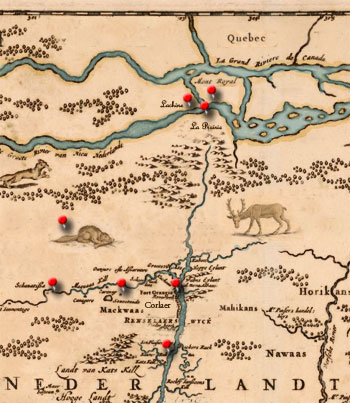Corlaer, le Pays de la Flamands.
Nieuw Nederland.
In 1660 the Dutch settler Arendt van Curler established a factorijen or trading post on the Mohawk River, in an area that he described as the "most beautiful land." He called it Schenectady, though the area was widely known as Corlaer as a nod to the man who was so well respected in the region. Located on the Mohawk River the post was about 20 miles west of Fort Orange (Albany) and 200 miles or so south of Montréal.

Traditional beaver trapping grounds were depleted due to the insatiable European demand for furs and the AmerIndians willingness to sell to them in exchange for Western goods they desired. The French, British and Native tribes did a dance, sometimes changing partners, to insure their supplies. When the French minister Jean-Baptiste Colbert attempted to limit the number of dealers by issuing congés or licenses in 1681, the English were still willing to deal. Frenchmen who participated in the trade without a license were known in Québec as coureur de bois, or wood-runners, and to the Dutch as bush-lopers.
By and large, the British paid better. Indians wishing to acquire a musket would have to deliver 5 beaver pelts to Montréal and only 2 to Fort Orange. Likewise 8 pounds of powder required 4 pelts to the French and only 1 pelt to the English.
Attack and Counter Attack.
Native peoples became increasingly dependent on trade with Europeans for guns, knives and other goods and formed alliances with those who better served their needs. The Dutch armed the Iroquois who then used their new found military might to push other tribes, the Huron, Mohican and Algonquin, from areas which still had a supply of animal pelts so crucial to their trade. The conflict known as the Beaver Wars was most active between 1642 and 1698.
Allied with the British, the Iroquois attacked the French village of Lachine just outside Montréal on 5 August 1689 killing many of the villagers. Events in the Old World played a role in Leisler's Rebellion in lower New York September 1689. Jacob Leisler, a German militiaman, led a movement for democratic rule in the colony after James II was deposed in England. He was hanged by the new king after a brief rule, and settlers were asked to sign an oath of loyalty, though that was not enough to quell the fire of liberty that continue to flicker throughout the land. THE NAMES AND SURNAMES OF THEM THAT HAUE TAKIN THE OATH OF ALLEGIANCE IN Ye COUNTY OF VLSTr, BY ORDr OF HIS EXCELY does include a Moses Depuis, though our ancestor would have been no more than 16 if this is indeed him.
The distraction of the Rebellion may have contributed to the success of a counterattack by the French as a reprisal for Lachine. On 8 February 1690 they invaded Schenectady. The wooden palisade was not sufficient to curb the slaughter. Under cover of a blizzard that kept the inhabitants in their home with a warm fire, the attackers slipped into the settlement. War cries warned the villagers too late of their fate. Within about two hours 60 men, women and children lay dead in the snow. Others were to perish from exposure during the harsh night. Twenty seven men were captured along with 50 horses that were brought back to Québec with defenders from Albany on their heels.
- https://www.newnetherlandinstitute.org/history-and-heritage/digital-exhibitions/arent-van-curler-and-the-flatts/the-story/rediscovering-the-flatts/
- Map from Library of Congress Nicolaes Visscher – Title: Novi Belgii Novæque Angliæ nec non partis Virginiæ tabula, 1685,Digital ID https://www.loc.gov/resource/g3715.ct004854/?r=0.336,0.082,0.243,0.188,0
- https://www.chroniclesofamerica.com/french/coureur_de_bois.htm: from "Documents Relating to the Colonial History of New York" (ix., 408-409) comparative table of prices at Fort Orange (Albany) and at Montreal in 1689
- New Horizons Genealogy /1689-census-ny-ulster
- From Tales of Old Schenectady by Larry Hart, Chapter 8, Page 37-40
- https://www.schenectadyhistory.org/resources/citycounty.html#city
